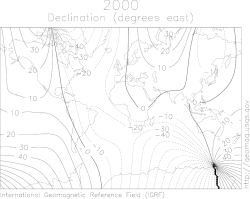North Magnetic Pole
The North Magnetic Pole is one of two places on the Earth where its magnetic field points vertically downwards. The other is the South Magnetic Pole.
At any other place on earth, the magnetic field points to the North Magnetic Pole. This is why a compass works to find where north is.
The North Magnetic Pole is not identical to the North Pole, which is the geographic north pole. It wanders slowly. In 2001, a team of scientists estimated that the North Magnetic Pole is near Ellesmere Island in northern Canada at 81°18′N 110°48′W / 81.3°N 110.8°W. It was estimated to be at 82°42′N 114°24′W / 82.7°N 114.4°W in 2005. As of 2015, the pole is thought to have moved east beyond the Canadian Arctic territorial claim to 86°18′N 160°00′W / 86.3°N 160.0°W.[1]
Because the North Magnetic Pole is different from the North Pole, a compass does not always point straight north. But usually the difference is small.
Because the Earth's magnetic field is not symmetrical, the South Magnetic Pole is not directly opposite. A line drawn from one to the other does not pass through the centre of the Earth.
North Magnetic Pole Media
Part of the Carta marina of 1539 by Olaus Magnus, depicting the location of magnetic north vaguely conceived as "Insula Magnetū[m]" (Latin for "Island of Magnets"), off modern-day Murmansk. The man holding the rune staffs is the Norse hero Starkad ("Starcaterus").
Related pages
References
- ↑ World Data Center for Geomagnetism, Kyoto. "Magnetic North, Geomagnetic and Magnetic Poles". Retrieved 2012-07-03.


